6 正说反译、反说正译法
- 格式:ppt
- 大小:115.00 KB
- 文档页数:9
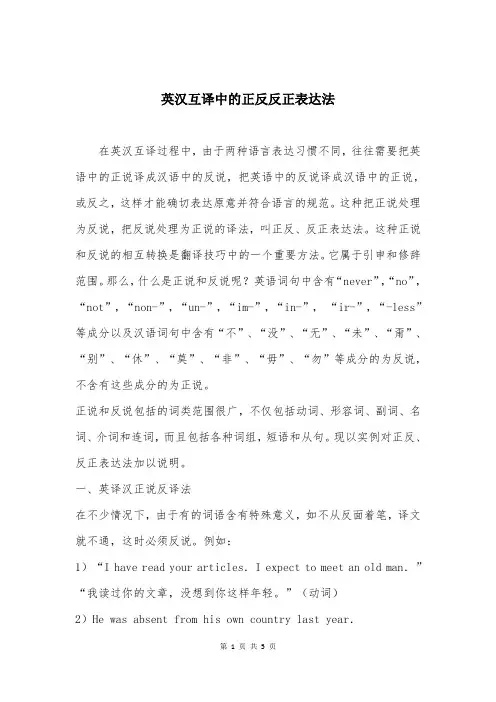
英汉互译中的正反反正表达法在英汉互译过程中,由于两种语言表达习惯不同,往往需要把英语中的正说译成汉语中的反说,把英语中的反说译成汉语中的正说,或反之,这样才能确切表达原意并符合语言的规范。
这种把正说处理为反说,把反说处理为正说的译法,叫正反、反正表达法。
这种正说和反说的相互转换是翻译技巧中的一个重要方法。
它属于引申和修辞范围。
那么,什么是正说和反说呢?英语词句中含有“never”,“no”,“not”,“non-”,“un-”,“im-”,“in-”,“ir-”,“-less”等成分以及汉语词句中含有“不”、“没”、“无”、“未”、“甭”、“别”、“休”、“莫”、“非”、“毋”、“勿”等成分的为反说,不含有这些成分的为正说。
正说和反说包括的词类范围很广,不仅包括动词、形容词、副词、名词、介词和连词,而且包括各种词组,短语和从句。
现以实例对正反、反正表达法加以说明。
一、英译汉正说反译法在不少情况下,由于有的词语含有特殊意义,如不从反面着笔,译文就不通,这时必须反说。
例如:1)“I have read your articles.I expect to meet an old man.”“我读过你的文章,没想到你这样年轻。
”(动词)2)He was absent from his own country last year.他去年不在自己的国家。
(形容词短语)3)He dived into the water fully clothed and rescued the children.他衣服没脱就跳入水中,把孩子救了上来。
(副词)4)He was extremely sorry for the shortness of time.他对时间不足感到十分抱歉。
(名词)5)I do think that it is beyond his power to fulfill the task.我的确认为要完成这项任务是他力所不及的。
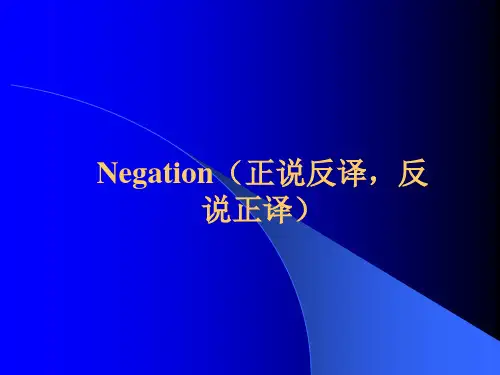
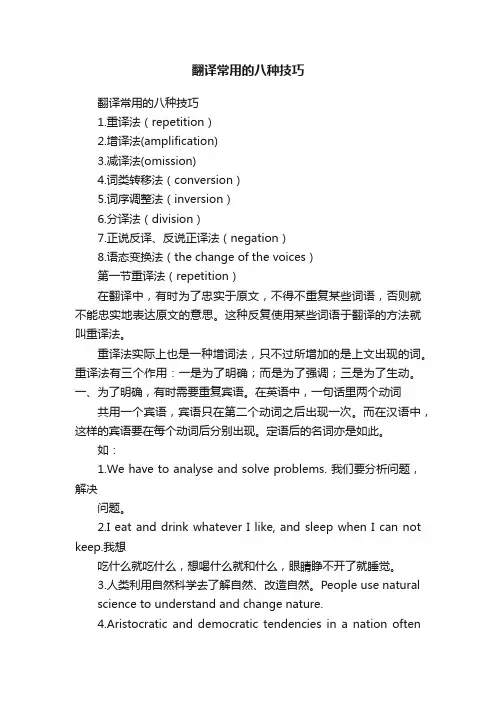
翻译常用的八种技巧翻译常用的八种技巧1.重译法(repetition)2.增译法(amplification)3.减译法(omission)4.词类转移法(conversion)5.词序调整法(inversion)6.分译法(division)7.正说反译、反说正译法(negation)8.语态变换法(the change of the voices)第一节重译法(repetition)在翻译中,有时为了忠实于原文,不得不重复某些词语,否则就不能忠实地表达原文的意思。
这种反复使用某些词语于翻译的方法就叫重译法。
重译法实际上也是一种增词法,只不过所增加的是上文出现的词。
重译法有三个作用:一是为了明确;而是为了强调;三是为了生动。
一、为了明确,有时需要重复宾语。
在英语中,一句话里两个动词共用一个宾语,宾语只在第二个动词之后出现一次。
而在汉语中,这样的宾语要在每个动词后分别出现。
定语后的名词亦是如此。
如:1.We have to analyse and solve problems. 我们要分析问题,解决问题。
2.I eat and drink whatever I like, and sleep when I can not keep.我想吃什么就吃什么,想喝什么就和什么,眼睛睁不开了就睡觉。
3.人类利用自然科学去了解自然、改造自然。
People use naturalscience to understand and change nature.4.Aristocratic and democratic tendencies in a nation oftenshowthemselves in its speech.民族的贵族倾向和民族倾向常在其言语中表现出来。
5.我们来修改安全规则和卫生规则吧。
Let’s revise our safety andsanitary regulations.二、英语常用省略,但为了明确,也为了强调某些内容,在汉语中常常要将省去的部分重译出来。

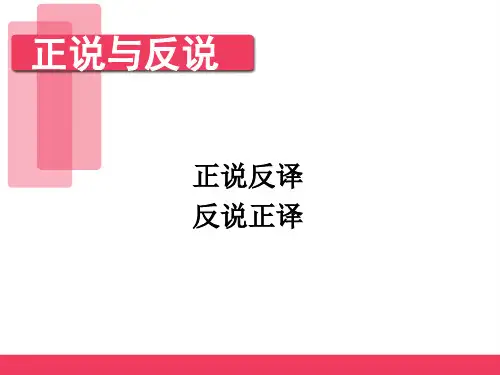
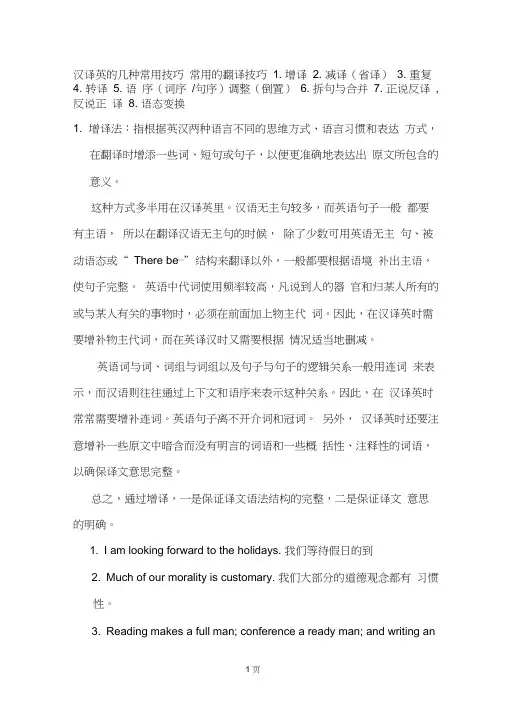
汉译英的几种常用技巧常用的翻译技巧 1. 增译 2. 减译(省译) 3. 重复4. 转译5. 语序(词序/句序)调整(倒置)6. 拆句与合并7. 正说反译, 反说正译8. 语态变换1. 增译法:指根据英汉两种语言不同的思维方式、语言习惯和表达方式,在翻译时增添一些词、短句或句子,以便更准确地表达出原文所包含的意义。
这种方式多半用在汉译英里。
汉语无主句较多,而英语句子一般都要有主语,所以在翻译汉语无主句的时候,除了少数可用英语无主句、被动语态或“ There be⋯”结构来翻译以外,一般都要根据语境补出主语,使句子完整。
英语中代词使用频率较高,凡说到人的器官和归某人所有的或与某人有关的事物时,必须在前面加上物主代词。
因此,在汉译英时需要增补物主代词,而在英译汉时又需要根据情况适当地删减。
英语词与词、词组与词组以及句子与句子的逻辑关系一般用连词来表示,而汉语则往往通过上下文和语序来表示这种关系。
因此,在汉译英时常常需要增补连词。
英语句子离不开介词和冠词。
另外,汉译英时还要注意增补一些原文中暗含而没有明言的词语和一些概括性、注释性的词语,以确保译文意思完整。
总之,通过增译,一是保证译文语法结构的完整,二是保证译文意思的明确。
1. I am looking forward to the holidays. 我们等待假日的到2. Much of our morality is customary. 我们大部分的道德观念都有习惯性。
3. Reading makes a full man; conference a ready man; and writing anexact man.读书使人充实,讨论使人机智,笔记使人精确。
4. Histories make men wise; poets witty; the mathematics subtle; natural philosophy deep; moral grave; logic and rhetoric able to contend. 读史使人明智,读诗使人灵秀,数学使人周密,科学使人深刻,伦理使人庄重,逻辑修辞之学使人善辩。
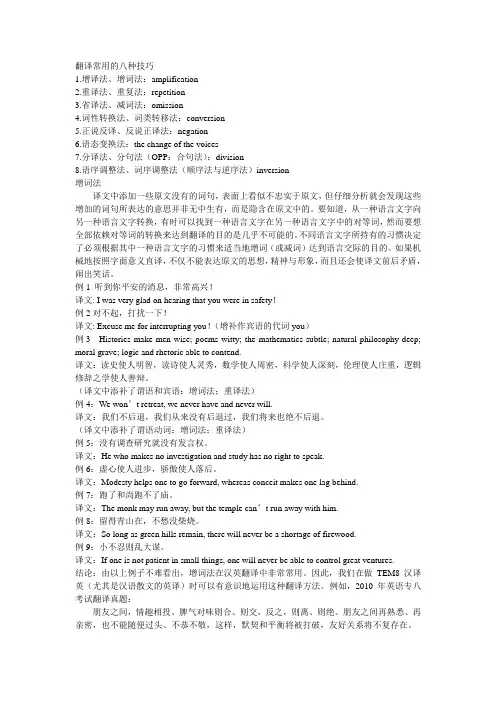
翻译常用的八种技巧1.增译法、增词法:amplification2.重译法、重复法:repetition3.省译法、减词法:omission4.词性转换法、词类转移法:conversion5.正说反译、反说正译法:negation6.语态变换法:the change of the voices7.分译法、分句法(OPP:合句法):division8.语序调整法、词序调整法(顺序法与逆序法)inversion增词法译文中添加一些原文没有的词句,表面上看似不忠实于原文,但仔细分析就会发现这些增加的词句所表达的意思并非无中生有,而是隐含在原文中的。
要知道,从一种语言文字向另一种语言文字转换,有时可以找到一种语言文字在另一种语言文字中的对等词,然而要想全部依赖对等词的转换来达到翻译的目的是几乎不可能的。
不同语言文字所持有的习惯决定了必须根据其中一种语言文字的习惯来适当地增词(或减词)达到语言交际的目的。
如果机械地按照字面意义直译,不仅不能表达原文的思想,精神与形象,而且还会使译文前后矛盾,闹出笑话。
例1 听到你平安的消息,非常高兴!译文: I was very glad on hearing that you were in safety!例2对不起,打扰一下!译文: Excuse me for interrupting you!(增补作宾语的代词you)例3 Histories make men wise; poems witty; the mathematics subtle; natural philosophy deep; moral grave; logic and rhetoric able to contend.译文:读史使人明智,读诗使人灵秀,数学使人周密,科学使人深刻,伦理使人庄重,逻辑修辞之学使人善辩。
(译文中添补了谓语和宾语:增词法;重译法)例4:We won’t retreat, we never have and never will.译文:我们不后退,我们从来没有后退过,我们将来也绝不后退。
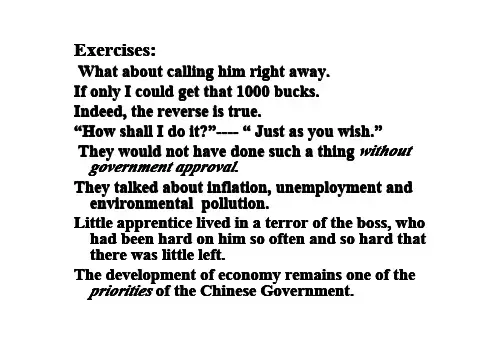
E xercises:What about calling him right away.I f only I could get that 1000 bucks.I ndeed, the reverse is true.“How shall I do it?Just as you wish.””How shall I do it?””-------- ““ Just as you wish.They would not have done such a thing without government approval.They talked about inflation, unemployment and environmental pollution.L ittle apprentice lived in a terror of the boss, who had been hard on him so often and so hard that there was little left.The development of economy remains one of the priorities of the Chinese Government.词法的翻译技巧(四)—— 反译法(negation)Try to translate the following sentences:No smoking!we must never stop taking an optimistic view of life.Wet paint!Just make yourself at home.that.Catching me do that.Catching me dopronunciation is no better than mine.H er er pronunciation is no better than mine.反译法(正说反译、反说正译)英语与汉语对同一概念的表达并不总是一致的。
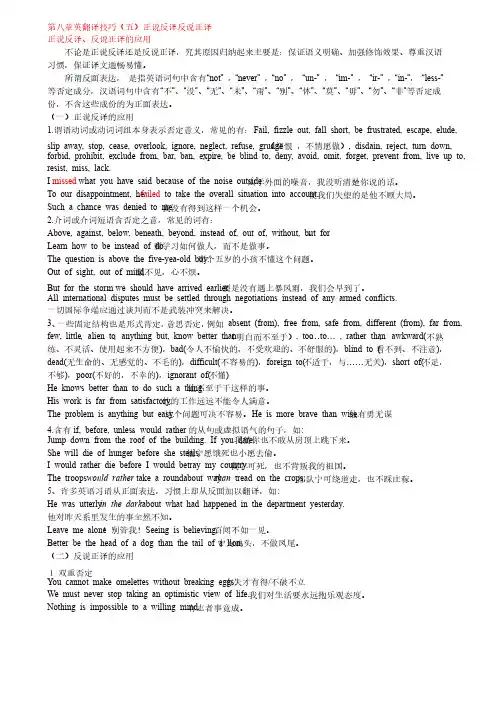
第八章英翻译技巧(五)正说反译反说正译正说反译、反说正译的应用不论是正说反译还是反说正译,究其原因归纳起来主要是:保证语义明确、加强修饰效果、尊重汉语习惯,保证译文通畅易懂。
所谓反面表达,是指英语词句中含有“not”,“never”,“no”,“un-”,“im-”,“ir-”,“in-”,“less-”等否定成分,汉语词句中含有“不”、“没”、“无”、“未”、“甭”、“别”、“休”、“莫”、“毋”、“勿”、“非”等否定成份,不含这些成份的为正面表达。
(一)正说反译的应用1.谓语动词或动词词组本身表示否定意义,常见的有:Fail, fizzle out, fall short, be frustrated, escape, elude, slip away, stop, cease, overlook, ignore, neglect, refuse, grudge(怨恨,不情愿做), disdain, reject, turn down, forbid, prohibit, exclude from, bar, ban, expire, be blind to, deny, avoid, omit, forget, prevent from, live up to, resist, miss, lack. I missed what you have said because of the noise outside.由于外面的噪音,我没听清楚你说的话。
To our disappointment, he failed to take the overall situation into account. 使我们失望的是他不顾大局。
Such a chance was denied to me.我没有得到这样一个机会。
2.介词或介词短语含否定之意,常见的词有:Above, against, below, beneath, beyond, instead of, out of, without, but for。
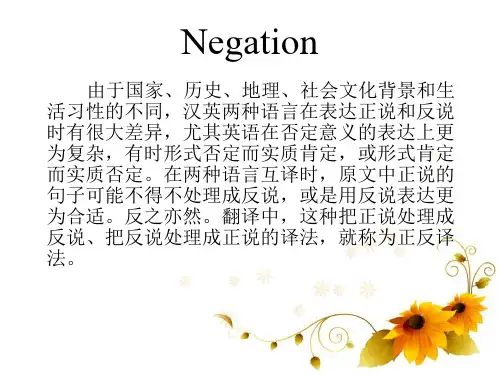
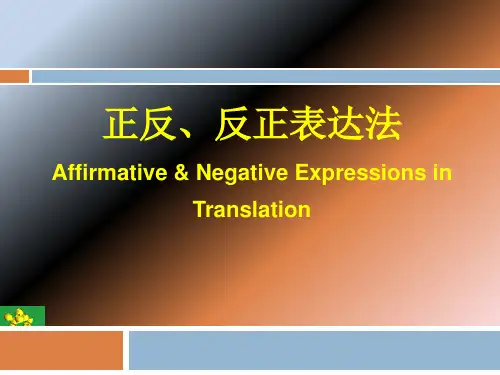
Eight translation techniques1.增译法(amplification);2.重译法(repetition);3.减译法(omission);4.词类转移法(conversion);5.词序调整法(inversion):6.分译法(division);7.正说反译,反说正译(negation);8.语态变换法(the change of the voices)Group competition1.I am looking forward to the holidays.我在等待假日的到来.2.Much of our morality is customary.我们大部分的道德观念都有习惯性。
3.Courage in excess becomes foolhardiness,affection weakness,thrift avarice.勇敢过度,即成蛮勇;感情过度,即成溺爱;俭约过度,即成贪婪。
4. Histories make men wise;poets witty;the mathematics subtle;natural philosophy deep;moral grave;logic and rhetoric able to contend.读史使人明智,读诗使人灵秀,数学使人周密,科学使人深刻,伦理使人庄重,逻辑修辞使人善辩。
5. As an Oriental,I cannot but be proud of your historic achievement.作为一个东方人,我不得不为贵国所取得的历史性成就感到骄傲。
Amplification 增译法Three types: Semantic amplification,Grammatical amplification,Rhetoric amplificationSemantic amplification1. The crowds melted away人群渐渐散开了.2. We were all greatly moved by his loftiness.我们都被他那种崇高品质所深深感染.3. He felt the patriot rise within his breast.他感到一种爱国热情在胸中激荡.loftiness patriot: 英语习惯运用抽象词汇,而汉语习惯运用具体词汇将“抽象概念变为具体概念”,类似词汇如:arrogance, indifference, tension,confusion, solution, remedies, jealousy, fault-finding增补概括性的词1. The advantages of the meeting room are bright, spacious, fashionable, and without echoes.这个会议室有四大优点:明亮、宽敞、时髦、无回声。
正说反译与反说正译英语和汉语有相同之处,那就是在表达同一事物或同一概念时,往往可以从正面叙述,也可以从反面叙述。
比如我们可以说“很困难”(quite difficult),也可以改成“很不容易”(far from easy);说做某事“竭尽全力”(do one’s best),也可以说“不遗余力”(spare no effect);可以说某个学生成绩“还好”(good),也可以说“不错”(not bad)。
但由于思维方式的不同,英语中有些从正面表达的东西在汉语中习惯从反面表达;而有些从反面来表达的东西在汉语中则习惯从正面来表达。
因此,英译汉时常常有必要进行转换。
这就是通常所说的“正说反译与反说正译”法。
如英语中的“wet Paint!”,汉语中常说成“油漆未干”,英语中说“I won’t keep you waiting long ”汉语中却说“我一会而就回来。
”1、正说反译:Miss the bus没有赶上车Live up to the expectations of my parent不辜负父母的期望Be absent from the meeting没有出席会议A final decision不可更改的决定Frost-free refrigerator无霜冰箱Freeze别动Mortally ill不治之症The window refuses to open窗户打不开The explanation is pretty thin这个解释站不住脚Beauty is but skin deep.美丽但不肤浅。
Opportunity knocks but once.机会只来一次。
Keep upright切勿倒置。
Agreeable sweetness甜而不腻。
I doubt it我不相信。
Mind your steep当心脚下。
2、反说正译:The specification lacks detail.说明书不够详细。
翻译常用的八种技巧一、常用的翻译技巧1. 重复法(repetition)2. 增译法(amplification)3. 减译法(omission)4. 词类转移法(conversion)5. 词序调整法(inversion)6. 分译法(division)7. 正说反译, 反说正译法(negation)8. 语态变换法(the change of the voices)1. 重复法汉语重复,英译时也重复;根据两种语言各自的习惯用法,以不同的表达方式进行重复,这种重复通常是为了传达原文的生动性.We have to analyze and solve problems.我们要分析问题,解决问题。
Let’s revise our safety and sanitary regulations.我们来修改安全规则和卫生规则吧。
Gentlemen may cry, peace, peace --- but there is no peace.先生们尽管可以高呼和平,和平!但是依然没有和平。
Nels had it all written out neatly.纳尔斯把它写得清清楚楚。
青青河边草, 郁郁园中柳。
Green grows the grass upon the bank,The willow shoots are long and lank.2. 增译法为了使译文忠实地表达原文的意思与风格并使译文合乎表达习惯,必须增加一些词语,这就叫增译法.增词义增加虚词为多,也可酌量增加实词。
英译汉时经常增加的词有结构词、数量词、概念词、语气词等。
从增补的功能来看,可以分为结构增补、意义增补和修辞增补。
I am looking forward to the holidays.我们等待假日的到来。
Much of our morality is customary.我们大部分的道德观念都有习惯性。
Reading makes a full man; conference a ready man; and writing an exact man.读书使人充实,讨论使人机智,笔记使人精确。
翻译理论与实践英译汉常用的方法和技巧:(6)反译法/正说反译、反说正译法(Negation)1. The certificate is invalid, if not under the steel seal.本证书加盖钢印方能生效。
2. They didn’t stop talking until they fell asleep.他们一直谈到入睡。
3. I shall not fail to help you when necessary.必要时我一定帮助你。
4. He left home before he had his breakfast.他没吃早饭就出去了。
5. He is a failure as a teacher.他教书不行。
6. 凡事皆有可能。
Nothing is impossible.7. 是不为也, 非不能也。
You could, if you would.英语、汉语中都有从正面或反面来表达一种概念的现象。
也就是说,人们在叙述同一事物或表达同一思想时,可以正说,也可以反说。
汉语如此,英语也如此。
我们不否认我们工作中有缺点。
我们承认我们工作中有缺点。
We admit that we have some shortcomings in our work.We do not deny that we have some shortcomings in our work.这里所谓正面表达和反面表达,主要是指英语中是否用“no, not, never”或“de-, dis-, non-, im-, in-, un-, -less”等否定性词缀的词;汉语中是否用“不、非、无、没、未、否、别、休、甭、孬、莫、勿、毋”等否定意义的字。
含这些成分的为反说,不含的为正说。
但是,由于语言习惯不同, 英汉两种语言在正说与反说方面也常常不同。
因此, 在翻译实践中, 原文中正说的词句有时不得不处理成反说; 原文中反说的词句有时不得不处理成正说。